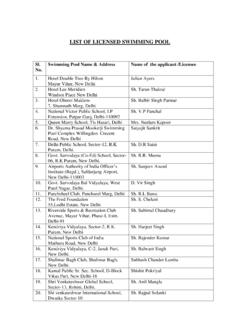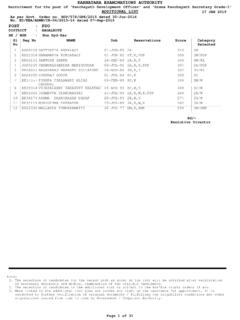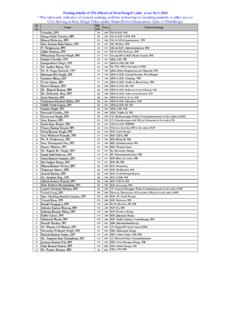Transcription of Compendium of Indicators for Nutrition-Sensitive …
1 Compendium of Indicators for Nutrition-Sensitive agriculture ii Compendium of Indicators for Nutrition-Sensitive agriculture Food and agriculture Organization of the United Nations Rome, 2016. The designations employed and the presentation of material in this information product do not imply the expression of any opinion whatsoever on the part of the Food and agriculture Organization of the United Nations (FAO) concerning the legal or development status of any country, territory, city or area or of its authorities, or concerning the delimitation of its frontiers or boundaries. The mention of specific companies or products of manufacturers, whether or not these have been patented, does not imply that these have been endorsed or recommended by FAO in preference to others of a similar nature that are not mentioned. The views expressed in this information product are those of the author(s).
2 And do not necessarily reflect the views or policies of FAO. ISBN 978-92-5-109461-7. FAO, 2016. FAO encourages the use, reproduction and dissemination of material in this information product. Except where otherwise indicated, material may be copied, downloaded and printed for private study, research and teaching purposes, or for use in non-commercial products or services, provided that appropriate acknowledgement of FAO as the source and copyright holder is given and that FAO's endorsement of users' views, products or services is not implied in any way. All requests for translation and adaptation rights, and for resale and other commercial use rights should be made via request or addressed to FAO information products are available on the FAO website ( publications) and can be purchased through Contents Foreword vi Acknowledgements vii 1. Overview & purpose 1. 2. Simplified impact pathways from agriculture to nutrition 3.
3 3. Types of agricultural investments and entry points for nutrition 4. 4. Which Indicators to choose: identifying impact pathways 6. 5. Planning M&E to capture selected Indicators 9. Glossary of terms in the framework 10. 6. Summary of key Nutrition-Sensitive Indicators 11. Table Recommended Indicators 11. Table Measurable outcomes for which various methods are available 12. 7. Detailed Compendium of existing Indicators for Nutrition-Sensitive investments 14. Table Diet quality Individual level 15. Table Food access Household level 21. Table On-farm availability, diversity and safety of food 26. Table Food environment in markets 28. Table Income 30. Table Women's empowerment 32. Table nutrition and food safety knowledge and norms 35. Table Care practices 36. Table Natural resource management practices, health and sanitation environment 38. Table Nutritional status: anthropometric Indicators 40.
4 Table Nutritional status: biochemical Indicators 41. References 43. Foreword 2016 marks the beginning of the Decade of Action on nutrition , which have centred on agriculture and food systems, given that inadequate access to follows the Second International Conference on nutrition (ICN2),1 during and consumption of healthy diets are common to all forms of malnutrition. This which FAO Member Countries reaffirmed their commitment to end all forms Compendium of Indicators for Nutrition-Sensitive agriculture is grounded in the of These include a range of manifestations such as stunting, concrete needs of programme and project officers for harmonized and reliable wasting, anaemia, and obesity. With the adoption by the United Nations General monitoring instruments, by providing an overview of relevant Indicators , along Assembly of the 2030 Agenda for Sustainable Development, a new indicator with recommendations on how to select the most appropriate ones, according framework will guide the monitoring efforts of the international community to the economic and social context.
5 Its purpose is to provide methodological in the period 2016-2030. The 2030 Agenda, and in particular the Sustainable information on currently available Indicators that may be relevant for the Development Goal 2 (SDG2), recognize agriculture and food systems as major Monitoring and Evaluation (M&E) of Nutrition-Sensitive agriculture investments. contributors to food security and nutrition . The experience of monitoring the This document is the result of a fruitful collaboration between the nutrition Millennium Development Goals (MDGs) has shown that what gets measured and Food Systems Division, the Investment Centre and the Statistics Division of gets done and that the effective use of data can help to galvanize development FAO. It aims to complement other guidelines for Nutrition-Sensitive programme efforts, implement successful targeted interventions, track performance and formulation, including the Key Recommendations for Improving nutrition improve The SDGs, ICN2, and the Decade of Action on nutrition through agriculture and Food Systems4 and Designing Nutrition-Sensitive call stakeholders including Governments, donors, businesses, and civil society agriculture Investments: Checklist and Guidance for Programme organizations to take action and to track, report and evaluate their results (and It is the result of a thorough process of review and extensive consultation within investment) on efforts to improve nutrition across multiple sectors.
6 In preparing FAO and with development partners. these new policy frameworks, extensive discussions at global and country level Anna Lartey Gustavo Merino Pietro Gennari Director Director Director nutrition and Food Systems Division Investment Centre Statistics Division FAO FAO FAO. vi Acknowledgements This Compendium was written by Anna Herforth (FAO), Giorgia F. Nicol . (FAO), Benoist Veillerette (FAO) and Charlotte Dufour (FAO). Special thanks goes to Anna-Lisa Noack (FAO) and Sophia Lyamouri (FAO) for their valuable contributions throughout the entire process. We are grateful to the following individuals who reviewed earlier drafts and generously provided feedback and inputs which improved the Compendium : Anna Lartey (FAO), Terri Ballard (FAO), Mary Arimond (UC Davis), Carlo Cafiero (FAO), Catherine Leclercq (FAO), Warren Lee (FAO), Catherine Bessy (FAO), Mary Kenny (FAO), Markus Lipp (FAO), Vittorio Fattori (FAO), Valentina Franchi (FAO), Marya Hillesland (FAO), Flavia Grassi (FAO), Pushpa Acharya (WFP), Emmanuelle Beguin (DFID), Heather Danton (USAID SPRING), James Garrett (IFAD), David Howlett (DFID), Aira Htenas (WB), Victoria Quinn (HKI), Rolf Klemm (HKI), Frederick Grant (HKI), Suneetha Kadiyala (LSHTM), Edye Kuyper (UC Davis), Yves Martin-Pr vel (IRD), William Masters (Tufts University), Quinn Marshall (WFP), Zalynn Peishi (DFAT), Victor Pinga (USAID SPRING), Melissa Williams (WB), Sara Marjani Zadeh (FAO), Camelia Bucatariu (FAO), Bin Liu (FAO).
7 Finally, the support of Illia Rosenthal, editor (FAO), Juan Luis Salazar, graphic artist (FAO) and Chiara Deligia, communication officer (FAO) are warmly acknowledged. The development of this Compendium was made possible with the support from the European Union through the Improved Global Governance for Hunger Reduction Programme. vii 1. Overview & purpose In November 2014, during the Second International Conference on nutrition This Compendium has been designed to support officers responsible for (ICN2), the Member Countries of the UN Food and agriculture Organization designing Nutrition-Sensitive food and agriculture investments, in selecting (FAO) and World Health Organization (WHO) adopted the Rome Declaration appropriate Indicators to monitor if these investments are having an impact on on nutrition and its Framework for Action. By doing so, they committed nutrition (positive or negative) and if so, through which pathways.
8 It provides to addressing all forms of malnutrition, including chronic and acute an overview of Indicators that can be relevant as part of a Nutrition-Sensitive undernutrition, overweight and diet-related non-communicable diseases, and approach, together with guidance to inform the selection of Indicators . micronutrient deficiencies. Achieving these commitments requires reviewing The purpose of this Compendium is to provide a current compilation of the way food systems the processes whereby food is produced, processed, Indicators that may be measured for identified outcomes of nutrition - transported, marketed and consumed are being transformed. The ICN2. sensitive investments. This Compendium does not provide detailed guidance Framework for Action therefore places a strong emphasis on making food on how to collect a given indicator but points to relevant guidance materials. systems related policies and investments Nutrition-Sensitive .
9 Governments and development partners are therefore increasingly including measures to ensure This Compendium does not represent official FAO recommendations that food and agriculture investments and policies contribute to improved for specific Indicators or methodologies. It is intended only to provide nutrition . These investments and policies cover a wide range of intervention information on the Indicators , methodologies and constructs that may be areas, including value chain development, increase the food production, relevant to consider in the monitoring and evaluation of Nutrition-Sensitive productivity and diversity, social and rural development. agriculture An investment policy, programme or project can be considered It is not envisaged that a single project should collect data on all the Nutrition-Sensitive if it aims to contribute to better nutrition by addressing some Indicators presented here.
10 The selection will be informed by the type of of the underlying determinants of nutrition access to safe and nutritious foods intervention implemented, the anticipated intermediary outcomes and (quantity and quality/diversity), adequate care, and a healthy and hygienic nutritional outcomes, as well as the feasibility of data collection in view of environment. Such projects need to demonstrate that they lead to results available resources and other constraints. toward improved nutrition . a In some cases, there is a construct for which there is no standard indicator or methodology. For example, income is an important construct for which there is not one precise gold standard methodology. Compendium of Indicators for Nutrition-Sensitive agriculture 1 Overview & purpose The advice of M&E experts and subject matter specialists,b should be sought in 2. The second part (chapter 6) is a summary of key Indicators for nutrition - making the final choice of Indicators and in planning the data collection and sensitive agriculture and food systems: currently available Indicators that analysis, including sampling and design of questionnaires.
















